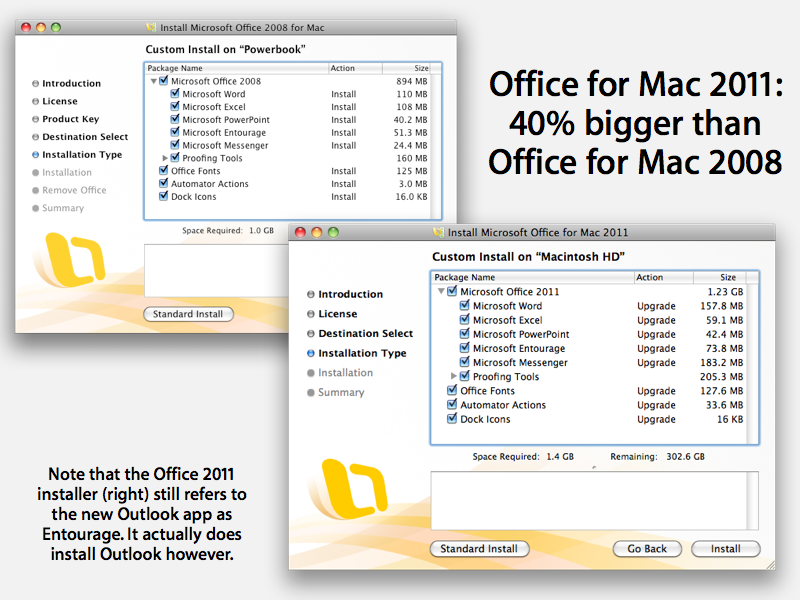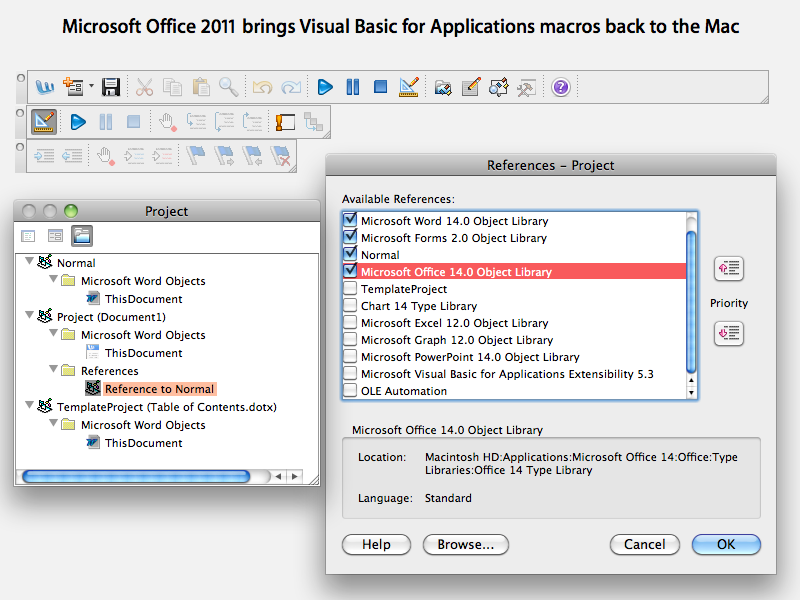Road to Office 2011: New looks, support for Exchange, VBA
Microsoft's Mac Business Unit, now headed by Eric Wilfrid, has refocused Office for Mac development to make the productivity suite more compatible cross platform, better looking, and better connected through plans to add co-authoring tools to enable collaborative editing of documents.
What's new: collaboration and online sharing
"The new co-authoring tools in Office 2011 give you and your teammates the ability to work on a file from Word, PowerPoint or Excel [via the Office Web App version only] from different locations, brainstorm ideas, and stay on the same page regardless of time, geography or platform," Microsoft announced in a press release in February.
"Co-authoring improves the processes of working together, removing the pain and frustration of multiple versions, lost edits, or even trying to set a time for the group to meet. With this new feature you can keep track of your team with the Presence Everywhere feature that gives real-time status updates on who is working on the document directly in the application."
Microsoft is also working to integrate its Mac desktop suite into its Office Web Apps initiative designed to compete with Google Docs. Office 2011 ties directly into the Office Web Apps (which are themselves still in beta) to enable users to share documents over the Internet, across platforms. The company's Office Web Apps can be used to upload documents to a Windows Live account or using a corporate SharePoint server.
Microsoft's Office Web Apps are currently limited to a private pool of beta testers, and full functionality is not yet enabled. Eventually the online suite will allow online document editing. That should make it more like Google Docs than Apple's iWork.com service, which is limited to document sharing and collaborative notes among invited users. However, iWork.com has been open to the public since January 2009, when it was launched alongside the desktop version of iWork 09.
Office 2011 also bundles Communicator, a client app for working with Microsoft's Office Communications Server 2007 to provide multi-party audio and video conferencing, integrated with the corporate address book.
What's new: a cohesive Ribbon interface
After giving the previous Mac and Windows versions of Office wildly divergent interfaces, Microsoft is now working to establish common ground. The former Elements Gallery of Office 2008 has "evolved" into a Ribbon that borrows from the Fluent UI Microsoft created for Vista and Office 2007.
The latest versions of Office for both platforms will now use a more common, refined Ribbon interface, although there are still platform differences. Microsoft says the effort to sync up the cross platform experience in Office is motivated by the fact that 75% of Mac users also use a Windows PC.
On page 2 of 2: Exchange support in Outlook, VBA.
Microsoft is also finally getting around to adding better Exchange support to Office, ditching its Entourage app for an entirely new Outlook, which has been missing on the Mac for over a decade.
The original Outlook for Mac client used Microsoft's proprietary MAPI to talk to Exchange Server, just like the Windows version of Outlook. The problem was that MAPI is a mess of insecure RPC that was largely tied to Windows APIs, making it impossibly difficult to deliver cross platform while keeping features in parity and security in check. MAPI is essentially impossible for third parties to implement, and complex enough that even Microsoft didn't want to support it on its own Mac client.
In 2000, Microsoft decided to drop Outlook for Mac (which was a stagnating Classic Mac OS app) and start over with a native Carbon app that used Internet standard POP and IMAP. (Entourage was largely based upon Outlook Express for Mac, which itself was based upon Apple's Claris Emailer, through a migration of developer talent that flowed from Apple to Microsoft). The problem with Entourage was that many of the features of Exchange Server are not available using the standard IMAP protocol for Internet email. Additionally, Microsoft has recently started turning IMAP off by default on Exchange.
Microsoft worked to address this issue by giving Entourage support for accessing calendar and contact information via WebDAV, the same mechanism it had developed to enable Outlook Web Access and Windows Mobile devices to remotely access Exchange. However, WebDAV does not support some advanced features of Exchange and does not deliver great performance. Microsoft has since deprecated WebDAV as a way to connect to Exchange.
Starting with Exchange 2007, Microsoft moved a step away from both the old MAPI and WebDAV to introduce Exchange Web Services, which enable clients to communicate with Exchange via more conventional XML and SOAP. EWS is the technology Apple added in Snow Leopard to enable Mac OS X apps to work with Exchange. Previously, Mail, Contacts, and Calendar used WebDAV, which didn't work as well, nor as effeciently.
EWS still isn't on the level of MAPI (used by Outlook for Windows), but it does work pretty well. It's trailing in features such as support for Public Folders (something Microsoft has depreciated, but that many Exchange Server shops still use), delegation features, support for an "online mode" for only syncing recent items, or the use of "distribution group" contacts.
The new Outlook for Mac in Office 2011 appears to use EWS, just like Apple's Snow Leopard apps. Entourage originally used WebDAV, which was terribly slow. Microsoft has since patched it to make use of EWS, so the differences between Entourage and the new Outlook may not be as Earth shattering as some users might hope.
The new Outlook app is written from scratch as a new Cocoa app, so it does offer some advantages over Entourage in terms of having a streamlined user interface that works more like a Mac app, rather than being an ancient Carbon app rewarmed to feel slightly more native, as the rest of the Office suite is.
Notably, its Toolbar now works like a standard Mac OS X app with drag and drop customization, rather than the oddball toolbar-like strips Office uses, which are customized using a non-standard interface. Additionally, the new Outlook for Mac will enable users to migrate their Windows .PST files (containing their locally stored mailboxes) to the Mac, which Entourage has not previously been able to import.
Overall, Office 2011 is currently about 40% larger than Office 2008. The new Cocoa-based Outlook is about the same amount larger than the Carbon-based Entourage app it replaces (the beta 2 installer continues to refer to Outlook at Entourage, although it does actually install the new Outlook app).
What's new: VBA support
In addition to the revamped Outlook, Office 2011 apps will also again support VBA macros, something Microsoft dropped while bringing Office 2008 to market. A the time, Microsoft said the feature was not very important to most Mac users, and that its removal was largely prompted by the necessity to make Office 2008 a Universal Binary supporting Intel Macs.
Microsoft explained that "the Macintosh VBA compiler [of the legacy Office code base] was originally designed for a much earlier PowerPC-based Macintosh and will not work, without significant modifications, on the Intel-based Macintosh. VBA macro code is compiled at runtime, and the compiler code, VB editor code, and VB forms code could not be converted for the Intel-based Macintosh without extensive programming work that would have significantly delayed the universal version of Office 2008.
"The Microsoft Office for Windows version of VBA can't be directly used for Office 2008 because it depends on execution of Windows machine assembly, which isn't compatible with the Mac OS."
Microsoft recommended that users affected by the change investigate using AppleScript as an alternative way to automate their document workflows. "The people most affected by the loss of VBA are those who need cross-platform programmability for Office," Microsoft said. Those people should now be happy to see VBA returning in the 2011 version of Office.
Other articles in this series:
For those readers interested in the history of Office on the Mac, please see the first segment of AppleInsider's Road to Mac Office 2008 series.
 Daniel Eran Dilger
Daniel Eran Dilger
















 Amber Neely
Amber Neely
 Thomas Sibilly
Thomas Sibilly
 AppleInsider Staff
AppleInsider Staff
 William Gallagher
William Gallagher
 Malcolm Owen
Malcolm Owen
 Christine McKee
Christine McKee










46 Comments
Wow that Windows Interface is ugly. At least compared to the Mac Version....
Wow that Windows Interface is ugly. At least compared to the Mac Version....
Really? I find myself liking the Windows interface better. I can't stress enough how happy I am that they are making the Mac interface similar to the Windows counterpart. I am so familiar with the Windows version as I use it every day, all day for work. Now when I go home I won't be hunting and pecking on my Mac to find the tools I need in Office.
I can't wait. Needed VBA for school this quarter, had to launch up Win7 to do my assignments. With this thing we once again get some sort of partity with the Windows Folks and I can continue to use Mac exclusively for more things I do. Win-Mac collaboration is a good thing too. The interface looks pretty nice as well.
Really? I find myself liking the Windows interface better. I can't stress enough how happy I am that they are making the Mac interface similar to the Windows counterpart. I am so familiar with the Windows version as I use it every day, all day for work. Now when I go home I won't be hunting and pecking on my Mac to find the tools I need in Office.
I don't know. I really like the clean Mac look. I work with Office 2007 at work too, but in my opinion the new one really looks unpleasant. I don't like the smallish little Word-Symbol that obviously is supposed to replace the Office Button, and the even more washed out blue color. The Office/Word Button is vital for using Office and Ribbon-newbees will have a hard time trying to find out how to Print, Save as.. etc... The blueish ribbon also was somewhat iconic for Office, now it has this old white inlay. Don't like that... Guess they needed to change something so that everyone sees that the User feels that he is running the new Version of Office.
Love what the Mac Bu did! Great Job. Maybe will even buy Office for Mac this time!Edit: Yeah I know I'm picky, but thats why I use a Mac...
Great. Now the mac users at work will want me to write vb code behind their excel sheets. VB is one of the worst languages I've ever learned.